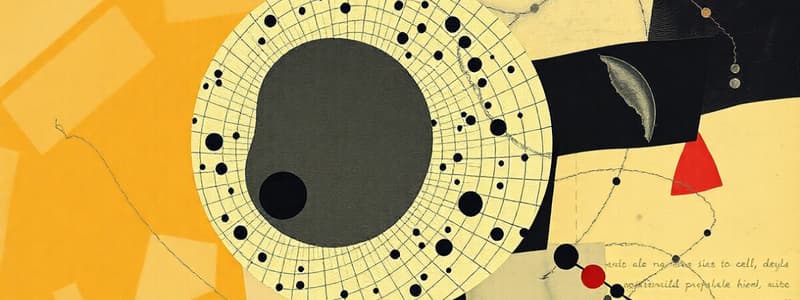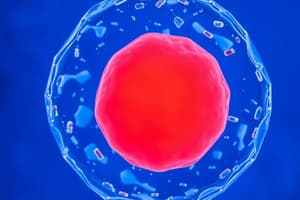Podcast
Questions and Answers
What is the primary function of the nuclear envelope?
What is the primary function of the nuclear envelope?
- Protect the nucleus and regulate substance passage (correct)
- Store genetic material
- Assist in protein synthesis
- Direct metabolic activities
Which of the following processes is directed by the nucleus?
Which of the following processes is directed by the nucleus?
- Nutrient transport
- Respiration
- Cell replication (correct)
- Waste elimination
What structural component primarily makes up the plasma membrane?
What structural component primarily makes up the plasma membrane?
- Proteins
- Nucleic acids
- Phospholipid bilayer (correct)
- Carbohydrate chains
What is the primary function of mitochondria within a cell?
What is the primary function of mitochondria within a cell?
How do phospholipids in the plasma membrane respond to water?
How do phospholipids in the plasma membrane respond to water?
Which component of the rough endoplasmic reticulum (RER) plays a crucial role in protein synthesis?
Which component of the rough endoplasmic reticulum (RER) plays a crucial role in protein synthesis?
What role do embedded proteins in the plasma membrane play?
What role do embedded proteins in the plasma membrane play?
What characteristic of the cytoplasm primarily contributes to the metabolic reactions occurring within it?
What characteristic of the cytoplasm primarily contributes to the metabolic reactions occurring within it?
Which of the following correctly describes the permeability of the plasma membrane?
Which of the following correctly describes the permeability of the plasma membrane?
Which of the following correctly describes the structure of the smooth endoplasmic reticulum (SER)?
Which of the following correctly describes the structure of the smooth endoplasmic reticulum (SER)?
What is a function of carbohydrate molecules in the plasma membrane?
What is a function of carbohydrate molecules in the plasma membrane?
Which of the following describes a role of the nucleus?
Which of the following describes a role of the nucleus?
What is a critical feature of the inner membrane of mitochondria that allows for efficient chemical reactions?
What is a critical feature of the inner membrane of mitochondria that allows for efficient chemical reactions?
Which statement is true regarding the rough endoplasmic reticulum (RER)?
Which statement is true regarding the rough endoplasmic reticulum (RER)?
Which ions and molecules are commonly found in the cytoplasm of a cell?
Which ions and molecules are commonly found in the cytoplasm of a cell?
What role does the plasma membrane play in cellular function?
What role does the plasma membrane play in cellular function?
What occurs to the chromosomes during anaphase?
What occurs to the chromosomes during anaphase?
Which of the following statements is true about telophase?
Which of the following statements is true about telophase?
How many chromosomes do daughter cells have after meiosis?
How many chromosomes do daughter cells have after meiosis?
What key process occurs during interphase?
What key process occurs during interphase?
What is the primary role of the spindle fibers during metaphase?
What is the primary role of the spindle fibers during metaphase?
What distinguishes meiosis II from meiosis I?
What distinguishes meiosis II from meiosis I?
Which type of transport uses ATP to move substances across cell membranes?
Which type of transport uses ATP to move substances across cell membranes?
During which stage do homologous chromosomes swap DNA?
During which stage do homologous chromosomes swap DNA?
Which feature is characteristic of cells in interphase?
Which feature is characteristic of cells in interphase?
What happens to the cytoplasm during cytokinesis?
What happens to the cytoplasm during cytokinesis?
Flashcards are hidden until you start studying
Study Notes
The Nucleus
- The nucleus is the largest structure in a cell.
- The nuclear envelope has a double membrane, with the outer layer connected to the endoplasmic reticulum.
- The envelope contains pores which allow substances to pass through.
- The nucleus stores genetic material (DNA).
- It directs all metabolic activities of the cell, including growth, metabolism, protein synthesis, and reproduction (cell division).
- The nucleus also instructs the synthesis of proteins/ribosomes and RNA.
Plasma (Cell) Membrane
- The plasma membrane is partially permeable and composed of a double layer of lipids, mostly phospholipids.
- The phospholipid molecules have hydrophilic ("water-loving") phosphate ends that face outwards and hydrophobic ("water-fearing") lipid tail regions that face inwards.
- The membrane also contains proteins and carbohydrate molecules embedded within or attached to its surface.
Functions of the Plasma Membrane and Its Proteins
- Regulates the transport of substances into and out of the cell.
- Acts as receptors (recognition sites) for substances such as hormones.
- Allows directed cell or organelle motility.
- Provides immunological identity due to the carbohydrate molecules within.
- Some proteins act as enzymes.
Cytoplasm
- The cytoplasm is a gel-like, semi-transparent fluid that fills most cells and is where metabolic reactions occur.
- It mainly consists of water with many solutes, including glucose, proteins, and ions.
- It contains vital cellular chemicals such as sodium, phosphates, chlorides, amino acids, ATP, and storage material like oil droplets.
Mitochondrion (Mitochondria)
- The mitochondria are known as the "powerhouse of the cell".
- It has outer and inner membranes.
- The inner membrane folds into cristae, maximizing surface area for chemical reactions to occur.
- Mitochondria are involved in cellular aerobic (O2) respiration, the process that makes chemical energy available in the cell.
- Energy in the form of ATP (Adenosine triphosphate) is formed from the catabolism of carbohydrates, fats, and proteins in the cell.
- The number of mitochondria varies depending on the cell and its function, with the highest number found in cells that are physically and metabolically active, such as skeletal muscles.
Rough Endoplasmic Reticulum (RER)
- The RER is a series of interconnected membranous canals that enclose flattened sacs called cisternae.
- It is an extension of the outer nuclear membrane.
- It has a large surface area for chemical reactions.
- It is covered with ribosomes, which make proteins.
Function of Rough Endoplasmic Reticulum
- Produces proteins, especially enzymes.
- Provides a pathway for the transport of materials through the cell.
- Collects and stores synthesized material.
- Provides a structural skeleton to maintain cellular shape.
Smooth Endoplasmic Reticulum (SER)
- The SER has similar features to the RER, but is found in large amounts in cells that secrete steroids, such as telophase.
Interphase
- During interphase, the cell grows and DNA synthesis occurs.
- Chromosomes replicate into two pairs of chromatids.
- Two pairs of centrioles appear.
Early Prophase
- Each chromosome has two chromatids joined at a centromere.
- The mitotic spindle, composed of microtubules and proteins, forms in the cytoplasm.
- The two pairs of centrioles move away from each other toward opposite ends of the cell.
Late Prophase
- The nuclear envelope breaks up.
- Microtubules that make up the spindle fibers reach from each cell pole to the cell's equator.
- Chromosomes/chromatids begin to migrate toward the cell center.
Metaphase
- The nuclear membrane disappears completely.
- Two pairs of centrioles align at opposite poles of the cell.
- Chromosomes/chromatids align at the metaphase plate at right angles to the spindle poles.
Anaphase
- The paired chromatids in each distinct chromosome begin to move apart.
- Once the paired sister chromatids separate from one another, each is considered a "full" chromosome, referred to as daughter chromosomes.
- The daughter chromosomes move to the poles at opposite ends of the cell.
Telophase
- Nuclei begin to form at opposite poles.
- The chromatin fibers of chromosomes uncoil.
- Cytokinesis, the division of the original cell's cytoplasm, begins before the end of mitosis and completes shortly after telophase.
- At the end of cytokinesis, there are two distinct daughter cells.
Meiosis
- Meiosis is the type of cell division that occurs in the formation of reproductive cells known as gametes: ova (eggs) and spermatozoa (sperm).
- The ova grow to maturity in the ovaries of the female and the spermatozoa in the testes of the male.
- After division, each daughter cell has only 23 chromosomes.
- When the ovum is fertilized, the resultant zygote has the full complement of 46 chromosomes, half from the father and half from the mother.
Stages of Meiosis - Meiosis I
- The chromosomes of the diploid cells replicate.
- Homologous (similar) chromosomes pair up.
- The stages are similar to mitosis.
- Homologous pairs swap some DNA.
- Two daughter cells are produced, each with only 23 chromosomes (haploid).
Stages of Meiosis - Meiosis II
- Meiosis II is similar to mitosis, and four daughter haploid cells are produced as a result.
Cellular Transport
- Transport of substances across cell membranes can be achieved through passive or active transport.
- Passive transport includes diffusion and osmosis and does not require energy.
- Active transport utilizes ATP (energy) to move substances across the cell membrane.
- Bulk transport includes pinocytosis (cell drinking) and phagocytosis (cell eating) and involves engulfing larger quantities of substances.
Studying That Suits You
Use AI to generate personalized quizzes and flashcards to suit your learning preferences.




